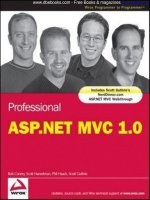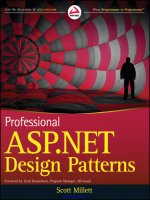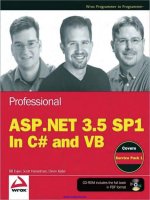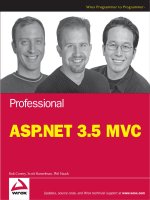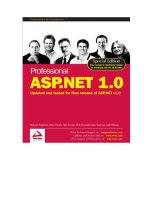Professional ASP.NET Design Patterns pptx
Bạn đang xem bản rút gọn của tài liệu. Xem và tải ngay bản đầy đủ của tài liệu tại đây (23.97 MB, 722 trang )
www.it-ebooks.info
www.it-ebooks.info
PROFESSIONAL
ASP.NET DESIGN PATTERNS
FOREWORD . . . . . . . . . . . . . . . . . . . . . . . . . . . . . . . . . . . . . . . . . . . . . . . . . . . . . . . . . . . . . . . . xix
INTRODUCTION xxi
PART I INTRODUCING PATTERNS AND PRINCIPLES
CHAPTER 1 The Pattern for Successful Applications . . . . . . . . . . . . . . . . . . . . . . . . . . . 3
CHAPTER 2 Dissecting the Pattern’s Pattern . . . . . . . . . . . . . . . . . . . . . . . . . . . . . . . . . 13
PART I I THE ANATOMY OF AN ASP.NET APPLICATION:
LEARNING AND APPLYING PATTERNS
CHAPTER 3 Layering Your Application and Separating Your Concerns . . . . . . . . . . 31
CHAPTER 4 The Business Logic Layer: Organization . . . . . . . . . . . . . . . . . . . . . . . . . . 55
CHAPTER 5 The Business Logic Layer: Patterns . . . . . . . . . . . . . . . . . . . . . . . . . . . . . . 95
CHAPTER 6 The Service Layer . . . . . . . . . . . . . . . . . . . . . . . . . . . . . . . . . . . . . . . . . . . . 153
CHAPTER 7 The Data Access Layer 195
CHAPTER 8 The Presentation Layer 289
CHAPTER 9 The User Experience Layer . . . . . . . . . . . . . . . . . . . . . . . . . . . . . . . . . . . . 375
PART II I CASE STUDY: THE ONLINE ECOMMERCE STORE
CHAPTER 10 Requirements and Infrastructure . . . . . . . . . . . . . . . . . . . . . . . . . . . . . . . 421
CHAPTER 11 Creating The Product Catalog 449
CHAPTER 12 Implementing the Shopping Basket 519
CHAPTER 13 Customer Membership 565
CHAPTER 14 Ordering and Payment . . . . . . . . . . . . . . . . . . . . . . . . . . . . . . . . . . . . . . . . 615
INDEX . . . . . . . . . . . . . . . . . . . . . . . . . . . . . . . . . . . . . . . . . . . . . . . . . . . . . . . . . . . . . . . . . . . . 673
www.it-ebooks.info
www.it-ebooks.info
PROFESSIONAL
ASP.NET Design Patterns
www.it-ebooks.info
www.it-ebooks.info
PROFESSIONAL
ASP.NET Design Patterns
Scott Millett
www.it-ebooks.info
Professional ASP.NET Design Patterns
Published by
Wiley Publishing, Inc.
10475 Crosspoint Boulevard
Indianapolis, IN 46256
www.wiley.com
Copyright © 2010 by Wiley Publishing, Inc., Indianapolis, Indiana
Published simultaneously in Canada
ISBN: 978-0-470-29278-5
ISBN: 978-0-470-94445-5
ISBN: 978-0-470-95289-4
ISBN: 978-0-470-95301-3
Manufactured in the United States of America
10 9 8 7 6 5 4 3 2 1
No part of this publication may be reproduced, stored in a retrieval system or transmitted in any form or by any means,
electronic, mechanical, photocopying, recording, scanning or otherwise, except as permitted under Sections 107 or 108
of the 1976 United States Copyright Act, without either the prior written permission of the Publisher, or authorization
through payment of the appropriate per-copy fee to the Copyright Clearance Center, 222 Rosewood Drive, Danvers,
MA 01923, (978) 750-8400, fax (978) 646-8600. Requests to the Publisher for permission should be addressed to the
Permissions Department, John Wiley & Sons, Inc., 111 River Street, Hoboken, NJ 07030, (201) 748-6011, fax (201)
748-6008, or online at />Limit of Liability/Disclaimer of Warranty: The publisher and the author make no representations or warranties with
respect to the accuracy or completeness of the contents of this work and specifically disclaim all warranties, including with-
out limitation warranties of fitness for a particular purpose. No warranty may be created or extended by sales or promo-
tional materials. The advice and strategies contained herein may not be suitable for every situation. This work is sold with
the understanding that the publisher is not engaged in rendering legal, accounting, or other professional services. If profes-
sional assistance is required, the services of a competent professional person should be sought. Neither the publisher nor
the author shall be liable for damages arising herefrom. The fact that an organization or Web site is referred to in this work
as a citation and/or a potential source of further information does not mean that the author or the publisher endorses the
information the organization or Web site may provide or recommendations it may make. Further, readers should be aware
that Internet Web sites listed in this work may have changed or disappeared between when this work was written and when
it is read.
For general information on our other products and services please contact our Customer Care Department within the
United States at (877) 762-2974, outside the United States at (317) 572-3993 or fax (317) 572-4002.
Wiley also publishes its books in a variety of electronic formats. Some content that appears in print may not be available
in electronic books.
Library of Congress Control Number: 2010929314
Trademarks: Wiley, the Wiley logo, Wrox, the Wrox logo, Wrox Programmer to Programmer, and related trade dress are
trademarks or registered trademarks of John Wiley & Sons, Inc. and/or its affiliates, in the United States and other coun-
tries, and may not be used without written permission. All other trademarks are the property of their respective owners.
Wiley Publishing, Inc. is not associated with any product or vendor mentioned in this book.
www.it-ebooks.info
This book is dedicated to my wonderful wife
Lynsey — not that she will read it, mind you.
www.it-ebooks.info
www.it-ebooks.info
ABOUT THE AUTHOR
SCOTT MILLETT is an enterprise software architect working in London for Wiggle.co.uk, an e-commerce
company specializing in cycle and triathlete sports. He has been working with .NET since version 1.0
and was awarded the ASP.NET MVP in 2010. He is the co-author of Wrox’s Professional Enterprise
.NET, and when not writing about or working with .NET he can be found relaxing and enjoying the
music at Glastonbury and all of the major music festivals in the UK during the summer. If you would
like to talk to Scott about the book, anything .NET, or the British music festival scene, feel free to write
to him at
, or by giving him a tweet @ScottMillett.
www.it-ebooks.info
www.it-ebooks.info
ACQUISITIONS EDITOR
Paul Reese
PROJECT EDITOR
Brian Herrmann
TECHNICAL EDITOR
Joe Fawcett
PRODUCTION EDITOR
Eric Charbonneau
COPY EDITOR
Karen Gill
EDITORIAL DIRECTOR
Robyn B. Siesky
EDITORIAL MANAGER
Mary Beth Wakefield
ASSOCIATE DIRECTOR OF MARKETING
David Mayhew
PRODUCTION MANAGER
Tim Tate
VICE PRESIDENT AND
EXECUTIVE GROUP PUBLISHER
Richard Swadley
VICE PRESIDENT AND EXECUTIVE PUBLISHER
Barry Pruett
ASSOCIATE PUBLISHER
Jim Minatel
PROJECT COORDINATOR, COVER
Lynsey Stanford
COMPOSITOR
James D. Kramer,
Happenstance Type-O-Rama
PROOFREADER
Jen Larsen, Word One
INDEXER
Johnna VanHoose Dinse
COVER PHOTO
© Özgür Donmaz/istockphoto.com
CREDITS
www.it-ebooks.info
ACKNOWLEDGMENTS
I WOULD LIKE TO THANK Brian Herrmann, Paul Reese, and all those at Wrox who have helped to cre-
ate this book. I would also like to thank Joe Fawcett who did a sterling job as the technical editor.
Massive thanks to Imar Spaanjaars ( for giving up his personal time
to review chapters and give me some great feedback.
I would also like to take the opportunity to thank a couple of people that I have learned a great deal
from over the last couple of years. I attended JP Boodhoo’s (
.NET
boot camp in the summer of 2009 and it was probably one of the most inspirational weeks I have
ever had, and it reminded me why I love the job I do. Thanks, JP.
When MVC first came along, a fellow named Rob Conery (
started a
blogging series on creating an MVC store. He explored many great technologies and methodologies
during the store’s construction, including BDD, TDD, DDD, KanBan, and Continuous Integration
to name but a few. I learned more than I could have possibly imagined, in no small part due to the
down-to-earth, fun manner in which Rob presented the content. If this book is half as good as those
videos, I will be a very happy man. Rob now has a company dedicated to providing great video
resources for developers at
www.tekpub.com/. It’s well worth a look — top banana.
www.it-ebooks.info
CONTENTS
FOREWORD xix
INTRODUCTION xxi
INTRODUCING PATTERNS AND PRINCIPLEPART I: S
THE PATTERN FOR SUCCESSFUL APPLICATIONS CHAPTER 1: 3
Design Patterns Explained 4
Origins 4
Necessity 4
Usefulness 5
What They Are Not 5
Design Principles 6
Common Design Principles 6
The S.O.L.I.D. Design Principles 7
Fowler’s Enterprise Design Patterns 8
Layering 8
Domain Logic Patterns 8
Object Relational Mapping 9
Web Presentation Patterns 10
Base, Behavioral, and Structural Patterns 10
Other Design Practices of Note 11
Test-driven Development (TDD) 11
Domain-driven Design (DDD) 11
Behavior-driven Design (BDD) 12
Summary 12
DISSECTING THE PATTERN’S PATTERN CHAPTER 2: 13
How to Read Design Patterns 13
Gang of Four Pattern Template 14
Simplified Template 14
Design Pattern Groups 15
Creational 15
Structural 15
Behavioral 16
How to Choose and Apply a Design Pattern 17
www.it-ebooks.info
xiv
CONTENTS
A Quick Pattern Example 18
Refactoring to Principles 20
Refactoring to the Adapter Pattern 22
Leveraging Enterprise Patterns 25
Summary 26
THE ANATOMY OF AN ASP.NET APPLICATION: PART II:
LEARNING AND APPLYING PATTERNS
LAYERING YOUR APPLICATION AND SEPARATING YOUR CHAPTER 3:
CONCERNS 31
Application Architecture and Design 31
Antipattern — Smart UI 32
Separating Your Concerns 37
Summary 53
THE BUSINESS LOGIC LAYER: ORGANIZATION 5CHAPTER 4: 5
Understanding Business Organizational Patterns 56
Transaction Script 56
Active Record 58
Domain Model 68
Anemic Domain Model 88
Domain-Driven Design 90
Summary 93
THE BUSINESS LOGIC LAYER: PATTERNS 9CHAPTER 5: 5
Leveraging Design Patterns 95
Factory Method 96
Decorator 100
Template Method 105
State Pattern 110
Strategy 115
Leveraging Enterprise Patterns 120
Specification Pattern 120
Composite Pattern 121
Layer Supertype Pattern 127
Applying Design Principles 130
Dependency Inversion Principle and the Dependency Injection Pattern 130
Interface Segregation Principle 137
Liskov Substitution Principle 141
Summary 151
www.it-ebooks.info
xv
CONTENTS
THE SERVICE LAYER CHAPTER 6: 153
Describing the Service Layer 153
Service Oriented Architecture 154
Four Tenets of SOA 156
The Facade Design Pattern 157
Leveraging Messaging Patterns 159
The Document Message and the Request-Response Patterns 159
The Reservation Pattern 160
The Idempotent Pattern 161
An SOA Example 162
Domain Model and Repository 163
Service Layer 171
Client Proxy 184
Client 188
Summary 192
THE DATA ACCESS LAYER CHAPTER 7: 195
Describing the DAL 195
Data Access Strategies 196
The Repository Pattern 196
Data Access Objects Pattern 197
Patterns in Data Access 197
Unit of Work 198
Data Concurrency Control 205
Lazy Loading and the Proxy Pattern 208
Identity Map 213
Query Object Pattern 215
Using an Object Relational Mapper 225
NHibernate 225
MS Entity Framework 226
ORM Code Example 227
Summary 285
THE PRESENTATION LAYER 28CHAPTER 8: 9
Inversion of Control 289
Factory Design Pattern 290
Service Locator 291
IoC Containers 292
Model-View-Presenter 296
ASP.NET Web Forms with MVP 297
www.it-ebooks.info
xvi
CONTENTS
Front Controller 319
Command Pattern 319
Chain of Responsibility Pattern 341
Model-View-Controller 348
ViewModel Pattern 349
The ASP.NET MVC Framework 349
Castle MonoRail 365
Page Controller 372
Summary 372
THE USER EXPERIENCE LAYER 37CHAPTER 9: 5
What Is AJAX? 375
Using JavaScript Libraries 376
Understanding AJAX Patterns 376
Periodic Refresh and Timeout 376
Unique URL 394
Databinding with JavaScript Templates 394
Predictive Fetch 412
Summary 417
CASE STUDY: THE ONLINE ECOMMERCE STORPART III: E
REQUIREMENTS AND INFRASTRUCTURE 4CHAPTER 10: 21
Agatha’s Clothing Store Requirements 421
Product Catalog and Basket Screens 422
Customer Account Screens 425
Checkout Screens 427
Caching and Logging 428
Architecture 428
Setting Up the Supporting Infrastructure 431
Summary 448
CREATING THE PRODUCT CATALOG 44CHAPTER 11: 9
Creating The Product Catalog 449
Product Catalog Model 450
Product Catalog Data Tables 454
Product Catalog Repositories 455
Product Services 468
Controllers 483
www.it-ebooks.info
xvii
CONTENTS
Product Catalog Views 493
Setting Up IoC 515
Summary 518
IMPLEMENTING THE SHOPPING BASKET CHAPTER 12: 519
Implementing the Basket 519
Basket Domain Model 519
Create the Basket Tables 529
NHibernate Mapping 529
Basket Service 533
Basket Controller and Basket Views 542
Summary 563
CUSTOMER MEMBERSHIP 56CHAPTER 13: 5
Customer Membership 565
Customer Model 565
Customer Data Tables 571
Customer NHibernate Mappings 571
Customer Service 574
Authentication Service 582
Customer Controller 590
Account Controllers 594
Customer Membership Views 604
Authentication Views 608
Summary 614
ORDERING AND PAYMENT CHAPTER 14: 615
Checkout 615
Order Model 615
Order Data Tables 631
Order NHibernate Mappings 631
Order Service 635
Taking Payment with PayPal 644
Order, Payment, and Checkout Controllers 653
Order and Checkout Views 662
Summary 672
INDEX 673
www.it-ebooks.info
www.it-ebooks.info
FOREWORD
Houses get built, manufacturing plants create stuff, and automobiles come off assembly lines
enabled by well-known and agreed upon patterns for building things. For well-understood tasks
there’s no reason to reinvent the wheel.
As Christopher Alexander said:
Each pattern describes a problem which occurs over and over again in our environment,
and then describes the core of the solution to that problem, in such a way that you can
use this solution a million times over, without ever doing it the same way twice.
When the Gang of Four (that you’ll learn about in a minute!) wrote the first Design Patterns book
for software engineers, it was the first time that patterns had been formally expressed in our disci-
pline. In this book, you’ll learn not just about patterns, but also antipatterns and what we can learn
from them as well.
Sometimes it’s not always clear what the best practice is, and mapping design pattern language to
tangible usage within ASP.NET can be a challenge. Scott Millett’s book takes those time tested
design patterns, teaches you how to read them, and then applies them in a concrete and specific way
to the problems that we as ASP.NET programmers have to deal with every day.
Filled with lots of code, instead of endless prose like some books, this book strives to connect
the dots and make these patterns real, applicable and relevant in your daily life as a developer. In
doing so, Millett calls upon not just what comes out of the box with ASP.NET from Microsoft, but
also shows us some of the gifts that open source software has given us like Castle ActiveRecord,
StructureMap, AutoMapper, and NHibernate.
From the Gang of Four to Uncle Bob’s S.O.L.I.D. to Fowler’s Enterprise patterns, Scott (what a
lovely name) connects timeless patterns to the timely technologies of today like jQuery and JSON,
the Entity Framework, and WCF.
I hope you enjoy reading it as much as I did.
Scott Hanselman
Program Manager – Microsoft
and @shanselman on Twitter
www.it-ebooks.info
www.it-ebooks.info
INTRODUCTION
THIS BOOK IS ALL ABOUT showing you how to use the power of design patterns and core design
principles in real ASP.NET applications. The goal of this book is to educate developers on the fun-
damentals of object oriented programming, design patterns, principles, and methodologies that
can help you become a better programmer. Design patterns and principles enable loosely coupled
and highly cohesive code, which will improve your code’s readability, flexibility, and maintenance.
Each chapter addresses a layer in an enterprise ASP.NET application and shows how proven pat-
terns, principles, and best practices can be leveraged to solve problems and improve the design of
your code. In addition, a professional-level, end-to-end case study is used to show how to use best
practice design patterns and principles in a real website.
WHO THIS BOOK IS FOR
This book is for ASP.NET developers who are comfortable with the .NET framework but are looking
to improve how they code and understand why design patterns, design principles, and best practices
will make their code more maintainable and adaptable. Readers who have had experience with design
patterns before may wish to skip Part 1 of the book, which acts as an introduction to the Gang of
Four design patterns and common design principles, including the S.O.L.I.D. principles and Martin
Fowler’s enterprise patterns. All code samples are written in C# but the concepts can be applied very
easily to VB.NET.
WHAT THIS BOOK COVERS
This book covers well-known patterns and best practices for developing enterprise-level ASP.NET
applications. The patterns used can be applied to any version of ASP.NET from 1.0 to 4.0. The patterns
themselves are language agnostic and can be applied to any object oriented programming language.
HOW THIS BOOK IS STRUCTURED
Professional ASP.NET Design Patterns can be used both as a step-by-step guide and as a continuous
source of reference to dip into at your leisure. The book is broken into three distinct sections. Part 1
is an introduction to patterns and design principles. Part 2 examines how patterns and principles can
be used in the various layers of an ASP.NET application. Part 3 represents an end-to-end case study
showcasing many of the patterns covered in the book. You may find it useful to work through the
chapters before reading the case study, or you may find it easier to see the patterns in action by read-
ing the case study section first and referring back to Part 2 for a more detailed view on the patterns
and principles used.
www.it-ebooks.info
xxii
INTRODUCTION
Part 1: Introducing Patterns and Principles
The first part of this book begins by introducing the concepts of design patterns, enterprise patterns,
and design principles, including the S.O.L.I.D. design principles.
Chapter 1: The Pattern for Successful Applications
This chapter explores why, as a professional developer, you need to understand design patterns and
principles, and more importantly, how to utilize them in a real-world enterprise-level application.
It covers the origins of the Gang of Four design patterns, their relevance in today’s world, and their
decoupling from specific programming languages. An overview of some common design principles
and the S.O.L.I.D. design principles follows, and the chapter ends with a description of Fowler’s
enterprise patterns.
Chapter 2: Dissecting the Pattern’s Pattern
This chapter introduces you to the practical knowledge necessary to use a design pattern template,
and how to read the GoF design patterns using the design templates. The chapter will then teach you
how to understand the design pattern groupings and give information on knowing how to choose
and apply a design pattern. The chapter finishes with an example on refactoring existing code to use
design patterns and principles to increase maintainability.
Part 2: The Anatomy of an ASP.NET Application:
Learning and Applying Patterns
Part two of the book shows how the patterns and principles introduced in the first two chapters can
be applied to various layers of an enterprise-level ASP.NET application.
Chapter 3: Layering Your Application and Separating Your Concerns
This chapter describes the benefits of a layered design over the traditional ASP.NET web forms
code-behind model. It goes on to cover the concepts of logical layering and the separation of your
application’s concerns. The chapter then defines the responsibilities of each distinct layer in an
enterprise-level ASP.NET application that will be covered in the remaining chapters of this part.
The chapter ends with an exercise in refactoring away from the Smart UI antipattern to a layered
architectural approach.
Chapter 4: The Business Logic Layer: Organization
This chapter covers patterns designed to organize your business logic layer. The chapter begins with
a description of the Transaction Script pattern followed by the Active Record, with an exercise to
demonstrate the pattern using the Castle Windsor project. The last pattern this chapter looks at
is the Domain Model pattern demonstrated in an exercise with NHibernate. The chapter ends with
a review of the domain-driven design (DDD) methodology and how it can be used to focus your
efforts on business logic rather than infrastructure concerns.
www.it-ebooks.info
xxiii
INTRODUCTION
Chapter 5: The Business Logic Layer: Patterns
Chapter 5, like the previous chapter, focuses on the business layer, but this time on the patterns and
principles that can be used construct your objects and how to make sure that you are building your
application for scalability and maintainability. The patterns covered include Factory, Decorator,
Template, State, Strategy, and Composite. Enterprise patterns are covered including Specification
and Layer Supertype. The chapter ends with some design principles that can improve your code’s
maintainability and flexibility; these include Dependency Injection, Interface Segregation, and
Liskov Substitution Principle.
Chapter 6: The Service Layer
This chapter covers the role that the service layer plays in an enterprise ASP.NET application. The
chapter starts with a brief look at Service Oriented Architecture and why it’s needed. The Facade
design pattern is then examined. Messaging patterns such as Document Message, Request-Response,
Reservation, and the Idempotent pattern are then covered. The chapter finishes with an exercise that
utilizes WCF to demonstrate all of the patterns covered in the chapter.
Chapter 7: The Data Access Layer
How to persist the state of your business objects with your data store is a critical part of your applica-
tion architecture. In this chapter, you will learn about design patterns utilized in this layer and how to
incorporate them. Two data access strategies are demonstrated to help organize your persistence layer:
Repository and Data Access Objects. The chapter then covers enterprise patterns and principles that
will help you fulfill your data access requirement needs elegantly, including Lazy Loading, Identity Map,
Unit of Work, and the Query Object. The chapter finishes with an introduction to Object Relational
Mappers and the problems they solve. An enterprise Domain Driven exercise with POCO business enti-
ties utilizing both NHibernate and the MS Entity Framework completes the chapter.
Chapter 8: The Presentation Layer
This chapter introduces you to patterns designed to organize the presentation logic and to keep it
separate from the other layers in your application. The chapter starts with an explanation of how you
can tie your loosely coupled code together with Structure Map, and an Inversion of Control container.
The chapter then moves on to describe a number of presentation patterns, including letting the view be
in charge with the Model-View-Presenter pattern and ASP.NET web forms, the Front Controller presen-
tation pattern utilizing the Command and Chain of Responsibility patterns, as well as the Model-View-
Controller Pattern implemented with the ASP.NET MVC framework and Windsor’s Castle Monorail
framework. The final presentation pattern covered is PageController as used in ASP.NET web forms.
The chapter ends with a pattern that can be used with organizational patterns, namely the ViewModel
pattern and how to automate domain entities to ViewModel mapping with AutoMapper.
Chapter 9: The User Experience Layer
In the final chapter of Part 2 the focus is set on the user experience layer. The chapter starts with
an explanation of what AJAX is and the technologies that make it possible. JavaScript libraries are
www.it-ebooks.info




